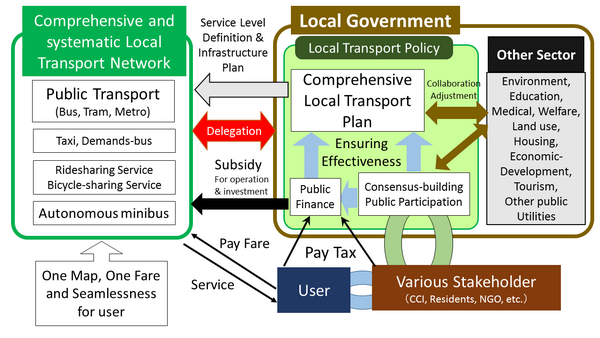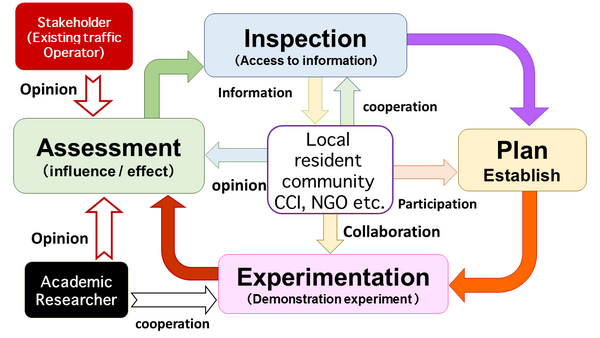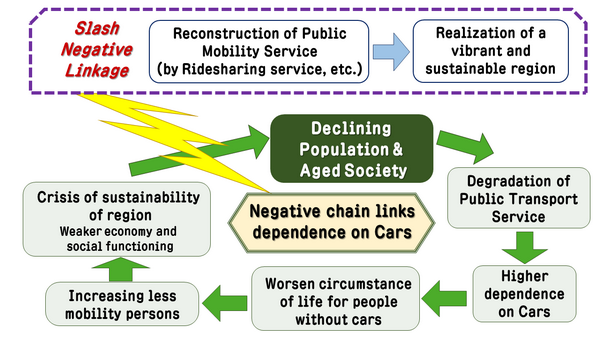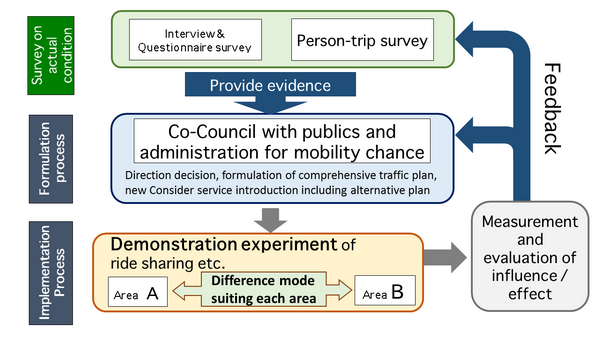Soichiro MinamiLocal Government and Innovation for Sustainable mobility: Policy, Role and MeansSocial BackgroundTransport or mobility policy faces to rapid change both institution and technology. Recently, rapid technology innovation of mobility has occurred. Some examples are autonomous car, innovation of customer service by ICT Revolution and innovative sharing service. On the other hands, traditional public transport had become innovative means by new technology, recent tramways have developed by new technology, and they are called Light Rail System (LRT). Many countries have undergone institutional reform of transportation policy for sustainability. Some countries established Transport act with sustainability standard, example “Transportation Codes” (ex. LOTI) in France (2010, LOTI Revised edition of 1996), “Transport Act 2000” in UK (2000), “Basic Act on Transportation Policy” in Japan (2013). Several international organizations, EU, OECD and so on, have worked on promoting sustainable transport. Contemporaneously decentralization of transportation policy has been promoted. Local governments have been given the responsibility for sustainable transportation policy. Academic BackgroundThe purpose of this research is analyzing Local Government as a main driver of innovative sustainable mobility, and interdependent development of institution and technology. About this theme, the existing research has the following three problems. The first is the division of research area between policy research and technical research in social science. There are two main disciplines, transport economics (TE) and management of technology (MOT). Range of TE is “transportation infrastructure” and “Management of public transport company”. Range of MOT is technical development of automobile. Inter-disciplinal work between TE and MOT hasn’t ever done. The second is lack of co-research of mobility with Environmental Economics (EE). The relationship between TE and EE has little exchange, but rather it is a kind of confrontational relationship. Lately, inter-disciplinal work between MOT and EE has started. However, it is still only a sprout. The third is lack of works about sustainable mobility from point of view of Local Governments. So one of research purpose is to Contribution to promotion of interdisciplinary research about innovative sustainable mobility. Research MethodThis research focus on the role of Local governments for introducing new technologies. In both case study and academic survey, roles and policy means of Local Governments are the main subject of this research. (1) Roles of Local Governments for development new technology of sustainable mobility (2) Policy means of Local Governments for social implementation of innovative mobility  Figure 1: comprehensive sustainable transport policy  Figure 2: IPEA cycle for innovative sustainable mobility (3) Difference among Local Governments in Level and Scale Research 1: introduction of new technology in French CitiesThis is a case study of French urban transport projects which have implemented these 30 years. There are many projects with innovative means or technologies, about both success and failure cases. Especially, innovation of tramway (LRT) or Bus Rapid Transit have developed many innovative technologies: low floor, tramway sur pneumatiques, power supply system without catenary and so on. Survey target cities are: Bordeaux (Success case of new LRT technology), Nancy (fail case of new LRT technology), Paris/Ile de France and Lyon (Demonstration operation of various new models) in addition Sion, Switzerland city, with the world's first demonstration operation Autonomous minibus. In addition, author research about innovation enterprises in France and Europe (Navia, Ez mile and so on). Research 2: Mobility innovation in Japanese rural areaMobility problem of rural area is “loss of mobility chance”. Due to the progress of motorization, many route buses have been abolished. So transportation-poor will lose many chance of education, commuting, hospital visits, and shopping, cultural exchanges and so on. They will not be able to live in rural area. The population of the rural area will decrease and economics activity will decline. The area cannot escape from the negative spiral and faces a crisis of sustainability. Innovative mobility can solve that mobility problem and create positive circulation of sustainable region (Fig 3 is one example). There are two research program of demonstration experiment in Japan. The first program is demonstration experiment of ridesharing service for transportation poor in Nakatonbetsu town in Hokkaido, which face a crisis to close main bus line. Nakatonbetsu town has introduced ridesharing service by UBER system from 2016 with strategy with escaping from the negative spiral and creating positive circulation (Fig.3). The second Program is experiment of new service of Niseko Town in Hokkaido. Niseko town has faced on problem of imbalance of transport demand for each season. In winter, many tourists, especially foreign visitors, come to Niseko and Bus and taxi supply is scarce. But in other season there are little demand of Bus and Taxi. This research includes all process from preliminary latent demand survey through demonstration operation (Fig. 4).  Figure 3: Nakatonbetsu town ridesharing Strategy for social sustainability  Figure 4: The plan of implementation new system in Niseko town Research 3: survey from view point of inter-disciplineThis is multidisciplinary cross-sectoral survey on sustainable mobility, for the purpose of showing comprehensive view of transportation research. Firstly, it is an interdisciplinary survey of Transport Economics and Management of Technology. The second is reexamination of the theory concerning the cost burden of transportation services (including urban transportation tax) and the manner of management. Third is the establishment of mobility-democracy. The public participation system in transport policy is getting more and more important. Innovation of sustainable mobility is one of drastic change in the market economic mechanism, “from goods to service”. In transport sector, it is said that car ownership will be replaced by service of car-use. Concept “MaaS” (Mobility as a Service) has been drawing attention. Contributions for establishing the theoretical foundation of MaaS will be made by this research. ReferencesSoichiro Minami, "Ridesharing Service in Local Gouvernements’ Transport Policy", 25th International Colloquium of GERPISA, ENS Cachan, CACHAN France, 15 June 2017, Language: English.Tetsuo Akiyama, Soichiro Minami, Hidetada Higashi et al., "The social experimentation and policy proposal for the ride sharing services in Japan", 25th International Colloquium of GERPISA, CACHAN France, June 14, 2017, Language: English. Nakatonbetsu Town (2017), Annual Report 2016 of Research Council for Sharing Economy, Nakatonbetsu Town, Language: Japanese. Soichiro MINAMI (2016), "Public Participation in Municipal Public Transportation Policy Comparison between Japan and France -Focus on Local Railway and Tramway". In Noriko OKUBO Ed. Green transportation policy and public participation, Osaka University Press, Suita, pp.205-206, Refereed Papers, Language: Japanese. Naoyuki TSUKAMOTO, Fumiko PERRY, Koji YOSHIKAWA, Soichiro MINAMI (2016), "A Study on Tram System Development in Spain and France, Based on the Case of 6 Cities", Osaka Sangyo University Journal of Human Environmental Studies, No.15, pp.101-137, Refereed Papers, Language: Japanese. Soichiro MINAMI (2012), "Implication from History of “Versement Transport” -French urban transport tax", Public finance and public policy, vol. 34 no.2, pp.122-137, Refereed Papers, Language: Japanese. |
 |
Recherche |  |
FFJ Research Statement |  |
Soichiro Minami |
| Inscrivez-vous à notre Lettre en cliquant ici |
*En cas de problème, vous pouvez aussi vous inscrire en envoyant un mail à sympa@ehess.fr, avec pour titre "subscribe ffj_french_news".






